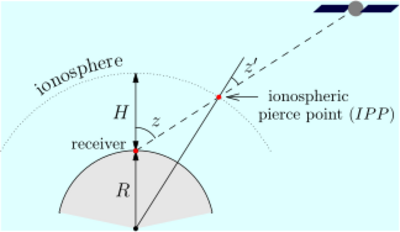Astronomy:Ionospheric pierce point

Most global navigation satellite systems (GNSS) are subjected to errors induced by the ionosphere. Because ionospheric delay affects the speed of microwave signals differently depending on their frequency—a characteristic known as dispersion, delays measured on two or more frequency bands can be used to measure dispersion, and this measurement can then be used to estimate the delay at each frequency.
The principal source of the dispersion comes from the total electron content (TEC) in the ionosphere, along the line of sight from the satellite to the receiver. Because it is difficult to measure the TEC along the line of sight, instead a prediction can be made using a simplified model of the ionosphere.
This model assumes that the ionosphere is a thin, uniform-density shell about the earth, located near the mean altitude H of maximum TEC (approx. 350 km). Using geometry, a slant intersection with this shell model can be determined and a vertical TEC measurement inferred. The intersection between line of sight and this shell is called the ionospheric pierce point (IPP). The perpendicular projection onto the earth's surface is called the subionospheric point.
References
Sources
- Satellite altimetry and earth sciences, By Lee-Leung Fu, Anny Cazenave, page 56.
External links
 |

